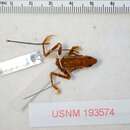en
names in breadcrumbs


Atelopus tricolor, known as the three-colored stubfoot toad, the three-colored harlequin toad and the Bolivian stubfoot toad, is one of the more than 65 recognized species in the Neotropical bufonid genus Atelopus. By both night and day, it is found near streams on the eastern slopes of the Andes, in primary montane forest between 600-2500 m asl.Its range, Southeastern Peru through the Yungas and Chapare regions of Bolivia, includes Madidi and Carrasco national parks and Manu Biosphere Reserve.This large distribution disputes Lötters’ (1996) theory that although lowland Atelopus frogs are known from wide distributions, montane Atelopus have small, restricted ranges (Lötters and de la Riva 1998; Salas et al. 2004).
A locally common (as of 2004), slim, small, long-legged toad, A. tricolor is considered part of the A. flavescens group. It is thought potentially susceptible to chytridiomycosis infection and listed as vulnerable by the IUCN especially as other montane Atelopus species have shown sharp declines, probably due to infection, augmented by degraded habitat, introduced predatory trout, and pollution.The three-colored stubfoot toad has red-orange spotting atop its greenish-black back, a red belly and yellow stripes along its sides and is distinguished from the similar and co-occurring A. erythropus by small, characteristic warts on its dorsum flanks, and limbs (Salas et al. 2004).
Males call in groups of 4-10, at night, and have been observed perching on vegetation at heights between 0.3-1.2 meters off the ground (Salas et al. 2004).Lavilla et al. (1996) described the tadpoles, collecting specimens from Peru and Bolivia.
The three-coloured harlequin toad (Atelopus tricolor) is a species of toad in the family Bufonidae. It is found in Bolivia and Peru. Its natural habitats are subtropical or tropical moist montane forests and rivers. It is threatened by habitat loss.
They have slim body; head is longer than broad; snout acuminate; nostril lateral not visible from above; eye width is about the same length as distance from nostril to anterior corner of eye. Loreal area barely convex; upper lip fleshy; immediate lateral postorbital are convex; temporal area slightly convex; tympanum absent; dorsal postorbital crest developed but not prominent. Tibia long; foot shorter than tibia; relative length of toes: 1<2<3<5<4; metatarsal tubercles poorly developed.[2]
The three-coloured harlequin toad (Atelopus tricolor) is a species of toad in the family Bufonidae. It is found in Bolivia and Peru. Its natural habitats are subtropical or tropical moist montane forests and rivers. It is threatened by habitat loss.